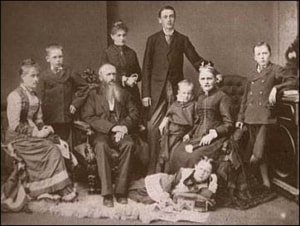 John and Mary Ann Heney with children, 1879
John and Mary Ann Heney with children, 1879 Pronounced HEEney, this street was laid out in early surveys but was not named until after the four cemeteries were closed. Early reminiscences talk about the heap of sand that remained there after the bodies had been taken out for burial elsewhere. City and private contractors apparently used the sand for road-making purposes.
John and Mary Ann Heney with children, 1879The street is named after John Heney (1821-1909), a man with a long association with Lowertown.
He was married in 1849 at Notre Dame on Sussex and attended the meeting convened to create St Brigid’s Parish in 1888. Over the decades, he built a reputation as a prominent local entrepreneur. On arrival in Bytown in 1844, he produced shoes and boots in the York Street workshop of the Protestant John Heney. By 1849, he had his own business, eventually with a shop and a house on Sussex Street. In 1868 he started supplying cordwood to heat the Parliament Buildings and built a company that supplied coal and then oil for furnaces up to the 1970s. No surprise that he became an alderman for the City of Ottawa in 1857 and served in this capacity until 1887
John and Mary Ann Heney with children, 1879The street is named after John Heney (1821-1909), a man with a long association with Lowertown.
He was married in 1849 at Notre Dame on Sussex and attended the meeting convened to create St Brigid’s Parish in 1888. Over the decades, he built a reputation as a prominent local entrepreneur. On arrival in Bytown in 1844, he produced shoes and boots in the York Street workshop of the Protestant John Heney. By 1849, he had his own business, eventually with a shop and a house on Sussex Street. In 1868 he started supplying cordwood to heat the Parliament Buildings and built a company that supplied coal and then oil for furnaces up to the 1970s. No surprise that he became an alderman for the City of Ottawa in 1857 and served in this capacity until 1887

 RSS Feed
RSS Feed